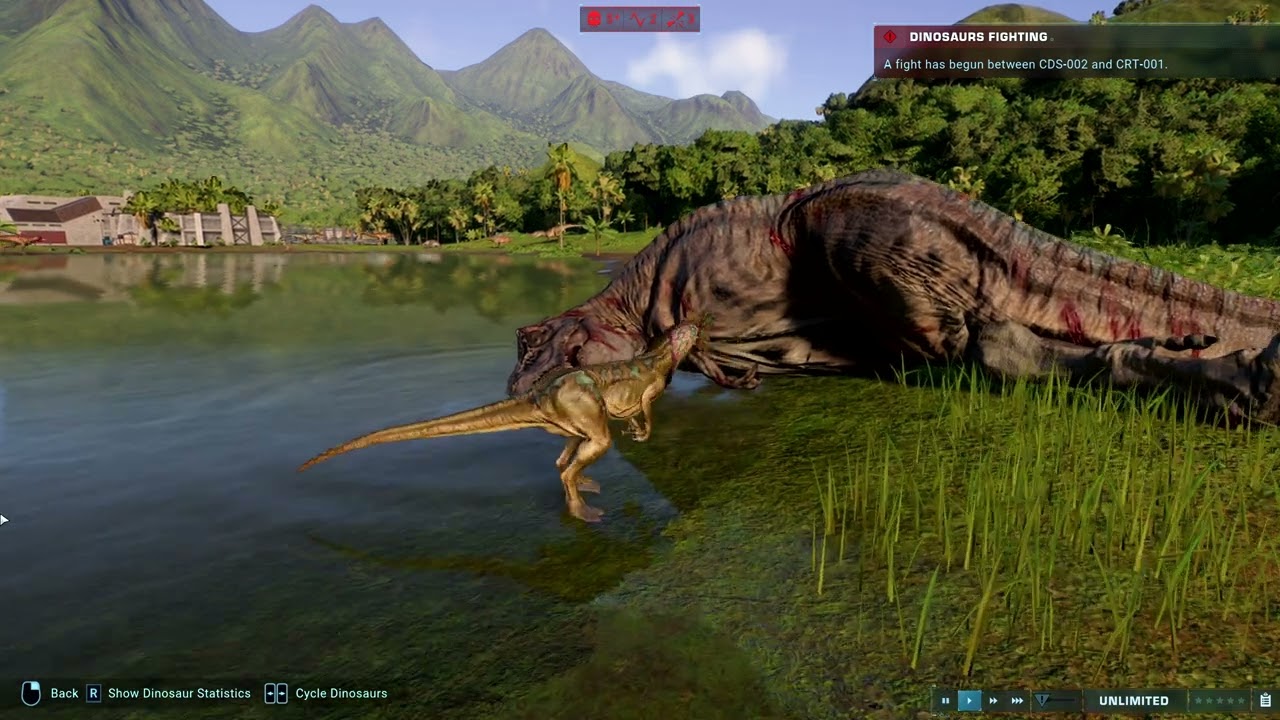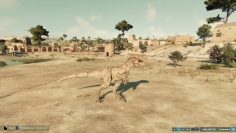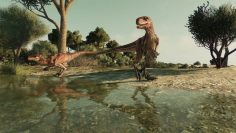Dilophosaurus vs Tyrannosaurus Rex
Tyrannosaurus rex (from Latinized Greek tyrannus ‘tyrant’ and saurus ‘lizard’, and Latin rex , ‘king’), 1 is the onlyknown species of the fossil genus Tyrannosaurus of tyrannosaurid theropod dinosaur , which lived in the late Cretaceous period , approximately 68–66 million years ago, 23 in the Maastrichtian , in whatis now North America . Its distribution on the continent was much wider than other tyrannosaurids. Commonly abbreviated as T. rex , and Castilianized as Tyrannosaurus 4 , it is a common figure in popular culture . It was one of the last non-avian dinosaurs to exist before the Cretaceous-Tertiary mass extinction .
Like other tyrannosaurids, T. rex was a bipedal carnivore with a huge skull balanced by a long, heavy tail . Relative to its long and powerful hindlimbs, Tyrannosaurus ‘s forelimbs were small, but surprisingly strong for their size, ending in two clawed toes . Although other theropods rival or exceed Tyrannosaurus rex in size, it is still the largest known tyrannosaurid and one of the largest known predators on Earth, measuring 12 to 13 meters long, 54 meters tall to thehips , 6 and with estimated weights between 6 to 9 tons . 5 For a long time it was the largest carnivore in its ecosystem; it must have been the apex predator , hunting hadrosaurids and ceratopsids , although some experts have suggested that it was primarily a scavenger . The debate over whether Tyrannosaurus was a dominant predator or a scavenger is one of the longest running in paleontology .
There are more than 30 identified Tyrannosaurus rex specimens , some of which are nearly complete skeletons . Connective tissue and protein have been found in at least one of these specimens. The abundance of fossil material has allowed many aspects of its biology to be investigated in detail , including its life cycle and biomechanics . The feeding habits , physiology , and potential speed of Tyrannosaurus rex are controversial. Its taxonomy is also controversial, with some scientists considering Tarbosaurus bataarfrom Asia as a second species of Tyrannosaurus while others maintain Tarbosaurus as a separate genus. Several other North American tyrannosaurid genera have also been synonymized to Tyrannosaurus .
https://es.wikipedia.org/wiki/Tyrannosaurus_rex
Dilophosaurus wetherilli ( Gr. “John Wetherill’s two-crested lizard”) is the onlyknown species of the extinct genus Dilophosaurus of dilophosaurid theropod dinosaur that lived in the early Jurassic period , approximately 200 to 190 million years ago, between the Sinemurian and Pliensbachian . , in what is now North America . The species Dilophosaurus sinensis , previously considered to belong to this genus, has been reclassified as belonging to the more modern synonym from the genus Sinosaurus , such as S. sinensis . 1
At about 7 meters in length, weighing about 400 kilograms , Dilophosaurus was one of the first large predatory dinosaurs, although smaller than some later theropods. He was slim and slightly built, and the skull was proportionally large, but delicate. The snout was narrow and the upper jaw had a gap from the nostril. It had a pair of plate-like longitudinal ridges on its skull, similar to a cassowary .with two ridges. The jaw was thin and delicate at the front, but deep at the back. The teeth were long, curved, thin, and compressed sideways. Those in the lower jaw were much smaller than those in the upper jaw. Most of the teeth had teeth on their front and back edges. The neck was long, and its vertebrae were hollow, and very light. The arms were powerful, with a long, thin arm bone. The hands had four fingers: the first was short but strong and had a large claw, the next two fingers were longer and thinner with smaller claws, and the fourth was vestigial. The thighbone was huge, the feet strong, and the toes clawed.
Paleontologists considered Dilophosaurus to be a basal genus that spawned clades such as ceratosaurs and tetanurans . Other paleontologists, on the contrary, think that in reality this genus is nothing more than a large coelophysid . The first specimens were described in 1954, but it was not until a decade later that the genus received its current name. Dilophosaurus is one of the oldest known Jurassic theropods, but also one of the least understood. Today it is considered a member of the Dilophosauridae family along with Dracovenator , a group located between the coelophysids and the later theropods. Dilophosaurus would have been active and bipedal, and may have hunted large animals and fed on smaller animals and fish as well. The function of the crests is unknown, they were too weak for battle, but they may have been used in display, such as species recognition and sexual selection. It may have grown rapidly, reaching a growth rate of 30 to 35 kilograms per year early in its life.
https://es.wikipedia.org/wiki/Dilophosaurus_wetherilli






